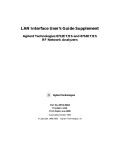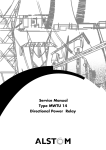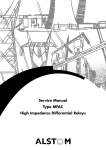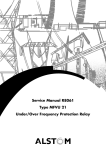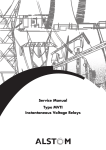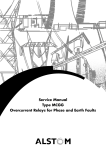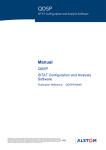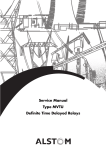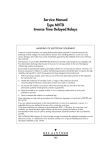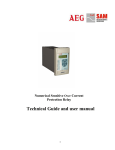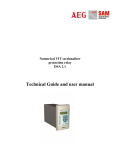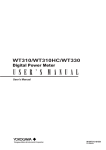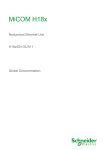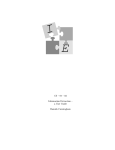Download Service Manual Type MWTU 11 Forward and Reverse Power Relay
Transcript
Service Manual Type MWTU 11 Forward and Reverse Power Relay Service Manual Type MWTU 11 Forward and Reverse Power Relay HANDLING OF ELECTRONIC EQUIPMENT A person's normal movements can easily generate electrostatic potentials of several thousand volts. Discharge of these voltages into semiconductor devices when handling electronic circuits can cause serious damage, which often may not be immediately apparent but the reliability of the circuit will have been reduced. The electronic circuits of ALSTOM T&D Protection & Control Ltd products are immune to the relevant levels of electrostatic discharge when housed in their cases. Do not expose them to the risk of damage by withdrawing modules unnecessarily. Each module incorporates the highest practicable protection for its semiconductor devices. However, if it becomes necessary to withdraw a module, the following precautions should be taken to preserve the high reliability and long life for which the equipment has been designed and manufactured. 1. Before removing a module, ensure that you are at the same electrostatic potential as the equipment by touching the case. 2. Handle the module by its front-plate, frame, or edges of the printed circuit board. Avoid touching the electronic components, printed circuit track or connectors. 3. Do not pass the module to any person without first ensuring that you are both at the same electrostatic potential. Shaking hands achieves equipotential. 4. Place the module on an antistatic surface, or on a conducting surface which is at the same potential as yourself. 5. Store or transport the module in a conductive bag. More information on safe working procedures for all electronic equipment can be found in BS5783 and IEC 60147-0F. If you are making measurements on the internal electronic circuitry of an equipment in service, it is preferable that you are earthed to the case with a conductive wrist strap. Wrist straps should have a resistance to ground between 500k – 10M ohms. If a wrist strap is not available, you should maintain regular contact with the case to prevent the build up of static. Instrumentation which may be used for making measurements should be earthed to the case whenever possible. ALSTOM T&D Protection & Control Ltd strongly recommends that detailed investigations on the electronic circuitry, or modification work, should be carried out in a Special Handling Area such as described in BS5783 or IEC 60147-0F. CONTENTS SAFETY SECTION 5 1. DESCRIPTION 9 2. 2.1 2.2 2.3 2.4 2.5 INSTALLATION General Relay mounting Unpacking Storage Site 9 9 9 9 10 10 3. 3.1 3.1.1 3.2 3.3 3.3.1 3.3.2 3.3.3 3.4 3.5 3.6 3.7 3.8 3.8.1 3.8.2 3.8.2.1 3.8.3 3.8.4 3.8.5 3.8.6 3.8.7 3.8.8 3.8.9 COMMISSIONING Commissioning preliminaries Electrostatic discharge (ESD) Wiring Inspection Removal of cover and case Connections Replace the module in the case and refit the cover. Insulation Earthing Main current transformers Commissioning equipment required Commissioning tests Calibrating phase shifter Power settings (%Pn) Commissioning procedure Relay boundary Instantaneous operating time Reverse operation check Time delayed operating time DDO operation Connecting relay to system Replace any links, wiring fuses and remove any CT short circuits 10 10 10 10 10 11 11 11 11 11 11 11 12 12 12 13 13 13 14 14 15 16 16 4. MAINTENANCE 16 5. 5.1 5.2 5.3 5.4 5.5 5.6 5.7 PROBLEM ANALYSIS General Visual examination of wiring Gaining access to the relay internal circuits Power supply pcb test CT test VT test Measuring pcb (ZJ0250) 16 16 17 17 17 18 18 18 6. Figure Figure Figure Figure Figure Figure SPARES 1. Application diagram for phase to phase reverse power connection 2. Application diagram for phase to neutral reverse power connection 3. Application diagram for phase to phase reverse VAR connection 4. Instantaneous operating times 5. Commissioning phase to phase connections 5. Commissioning phase to neutral connections 4 19 20 21 22 23 24 24 SAFETY SECTION This Safety Section should be read before commencing any work on the equipment. Health and safety The information in the Safety Section of the product documentation is intended to ensure that products are properly installed and handled in order to maintain them in a safe condition. It is assumed that everyone who will be associated with the equipment will be familiar with the contents of the Safety Section. Explanation of symbols and labels The meaning of symbols and labels which may be used on the equipment or in the product documentation, is given below. Caution: refer to product documentation Caution: risk of electric shock Protective/safety *earth terminal Functional *earth terminal. Note: this symbol may also be used for a protective/ safety earth terminal if that terminal is part of a terminal block or sub-assembly eg. power supply. *Note: The term earth used throughout the product documentation is the direct equivalent of the North American term ground. Installing, Commissioning and Servicing Equipment connections Personnel undertaking installation, commissioning or servicing work on this equipment should be aware of the correct working procedures to ensure safety. The product documentation should be consulted before installing, commissioning or servicing the equipment. Terminals exposed during installation, commissioning and maintenance may present a hazardous voltage unless the equipment is electrically isolated. If there is unlocked access to the rear of the equipment, care should be taken by all personnel to avoid electric shock or energy hazards. Voltage and current connections should be made using insulated crimp terminations to ensure that terminal block insulation requirements are maintained for safety. To ensure that wires are correctly terminated, the correct crimp terminal and tool for the wire size should be used. 5 Before energising the equipment it must be earthed using the protective earth terminal, or the appropriate termination of the supply plug in the case of plug connected equipment. Omitting or disconnecting the equipment earth may cause a safety hazard. The recommended minimum earth wire size is 2.5 mm2, unless otherwise stated in the technical data section of the product documentation. Before energising the equipment, the following should be checked: Voltage rating and polarity; CT circuit rating and integrity of connections; Protective fuse rating; Integrity of earth connection (where applicable) Equipment operating conditions The equipment should be operated within the specified electrical and environmental limits. Current transformer circuits Do not open the secondary circuit of a live CT since the high voltage produced may be lethal to personnel and could damage insulation. External resistors Where external resistors are fitted to relays, these may present a risk of electric shock or burns, if touched. Battery replacement Where internal batteries are fitted they should be replaced with the recommended type and be installed with the correct polarity, to avoid possible damage to the equipment. Insulation and dielectric strength testing Insulation testing may leave capacitors charged up to a hazardous voltage. At the end of each part of the test, the voltage should be gradually reduced to zero, to discharge capacitors, before the test leads are disconnected. Insertion of modules and pcb cards These must not be inserted into or withdrawn from equipment whilst it is energised, since this may result in damage. Fibre optic communication Where fibre optic communication devices are fitted, these should not be viewed directly. Optical power meters should be used to determine the operation or signal level of the device. 6 Older Products Electrical adjustments Equipments which require direct physical adjustments to their operating mechanism to change current or voltage settings, should have the electrical power removed before making the change, to avoid any risk of electric shock. Mechanical adjustments The electrical power to the relay contacts should be removed before checking any mechanical settings, to avoid any risk of electric shock. Draw out case relays Removal of the cover on equipment incorporating electromechanical operating elements, may expose hazardous live parts such as relay contacts. Insertion and withdrawal of extender cards When using an extender card, this should not be inserted or withdrawn from the equipment whilst it is energised. This is to avoid possible shock or damage hazards. Hazardous live voltages may be accessible on the extender card. Insertion and withdrawal of heavy current test plugs When using a heavy current test plug, CT shorting links must be in place before insertion or removal, to avoid potentially lethal voltages. Decommissioning and Disposal Decommissioning: The auxiliary supply circuit in the relay may include capacitors across the supply or to earth. To avoid electric shock or energy hazards, after completely isolating the supplies to the relay (both poles of any dc supply), the capacitors should be safely discharged via the external terminals prior to decommissioning. Disposal: It is recommended that incineration and disposal to water courses is avoided. The product should be disposed of in a safe manner. Any products containing batteries should have them removed before disposal, taking precautions to avoid short circuits. Particular regulations within the country of operation,may apply to the disposal of lithium batteries. 7 Technical Specifications Protective fuse rating The recommended maximum rating of the external protective fuse for this equipment is 16A, Red Spot type or equivalent, unless otherwise stated in the technical data section of the product documentation. Insulation class: IEC 61010-1:1990/A2: 1995 This equipment requires a Class I protective (safety) earth EN 61010-1: 1993/A2: 1995 connection to ensure user Class I safety. Installation Category (Overvoltage): IEC 61010-1:1990/A2: 1995 Distribution level, fixed Category III installation. Equipment in EN 61010-1: 1993/A2: 1995 this category is qualification Category III tested at 5kV peak, 1.2/50µs, 500Ω, 0.5J, between all supply circuits and earth and also between independent circuits. Environment: IEC 61010-1:1990/A2: 1995 Compliance is demonstrated by Pollution degree 2 reference to generic safety EN 61010-1: 1993/A2: 1995 standards. Pollution degree 2 Product safety: 73/23/EEC Compliance with the European Commission Low Voltage Directive. EN 61010-1: 1993/A2: 1995 Compliance is demonstrated EN 60950: 1992/A11:1997 by reference to generic safety standards. 8 Section 1. DESCRIPTION The MWTU 11 is a single phase relay measuring Icosφ, where I is the current flowing into the relay and φ is the phase angle between the current and voltage vectors. MWTU 11 relays are suitable for power measurement on systems where the system voltage is considered to be constant. With a balanced load, the single phase MWTU 11 may be used to measure the three phase power of the system. This is achieved by using a phase to neutral or phase to phase connection as indicated in Figures 1 and 2 respectively. For measuring VARs in a system the MWTU 11 may be used with a quadrature connection as shown in Figure 3. The Icosφ detector provides an instantaneous output, the operation time of this measuring unit varies with the relay setting and is given in Figure 4. The timer incorporated within the relay may be set to start timing from either pick up or drop off of the instantaneous element, this allows the MWTU 11 to be used for detecting either overpower or underpower conditions. A switch mode power supply is used to power the relay which is available in three different voltage ranges, 24/54V, 48/125V and 110/250V dc. Setting of the relay is achieved by a set of DIL switches on the front of the relay. These are calibrated to give a setting range of 1% to 32.5% Pn in steps of 0.5% Pn, where Pn is equal to In cosφ and a timer setting range of 0.25 to 32 seconds in steps of 0.25 seconds. Section 2. 2.1 INSTALLATION General Protective relays, although generally of robust construction, require careful treatment prior to installation and a wise selection of site. By observing a few simple rules the possibility of premature failure is eliminated and a high degree of performance can be expected. 2.2 Relay mounting The relays are either despatched individually or as part of a panel/rack mounted assembly in cartons specifically designed to protect them from damage. Relays should be examined immediately they are received to ensure that no damage has been sustained in transit. If damage due to rough handling is evident, a claim should be made to the transport company concerned immediately and ALSTOM T&D Protection & Control Ltd should be promptly notified. Relays which are supplied unmounted and not intended for immediate installation should be returned to their protective polythene bags. 2.3 Unpacking Care must be taken when unpacking and installing the relays so that none of the parts are damaged or their settings altered and must only be handled by skilled persons. Relays which have been removed from their cases should not be left in situations where they are exposed to dust or damp. This particularly applies to installations which are being carried out at the same time as construction work. 9 2.4 Storage If relays are not installed immediately upon receipt they should be stored in a place free from dust and moisture in their original cartons and where de-humidifier bags have been included in the packing they should be retained. The action of the dehumidifier crystals will be impaired if the bag has been exposed to ambient conditions and may be restored by gently heating the bag for about an hour, prior to replacing it in the carton. Dust which collects on a carton may, on subsequent unpacking, find its way into the relay; in damp conditions the carton and packing may become impregnated with moisture and the de-humidifying agent will lose its efficiency. The storage temperature range is –25˚C to +70˚C. 2.5 Site The installation should be clean, dry and reasonably free from dust and excessive vibration. The site should preferably be well illuminated to facilitate inspection. An outline diagram is normally supplied showing panel cut-outs and hole centres. For individually mounted relays these dimensions will also be found in publication R6127. Publication R7012, Parts Catalogue and Assembly Instructions, will be useful when individual relays are to be assembled as a composite rack or panel mounted assembly. Publication R6001 is a leaflet on the modular integrated drawout system of protective relay. Publication R6014 is a list of recommended suppliers for the pre-insulated connectors. Section 3. 3.1 COMMISSIONING Commissioning preliminaries Check that ratings of relay agree with the supplies to which the relay is to be connected. 3.1.1 Electrostatic discharge (ESD) The relay uses components which are sensitive to electrostatic discharges. When handling the withdrawn module, care should be taken to avoid contact with components and electrical connections. When removed from its case for storage the module should be placed in an electrically conducting anti-static bag. See full recommendations inside front cover. 3.2 Wiring Check all wiring connections to the relay, including the case earthing connection above the terminal block. The relay diagram number appears inside the case. 3.3 Inspection Before leaving the factory all relays are accurately adjusted, tested and carefully packed. Hence there should be no need for any re-adjustment on commissioning. 10 3.3.1 Removal of cover and case To gain access to the relay, first loosen the captive cover screws. Then carefully remove the cover from the case. The module can then be removed from the case by grasping the handles at the top and bottom of the front plate and pulling forwards. Care must be taken to ensure that mechanical settings of the element are not disturbed. 3.3.2 Connections Examine wiring connections and major components and ensure that there is no obvious mechanical damage. Do not adjust trimpots on the PCB. 3.3.3 Replace the module in the case and refit the cover. Make sure that the reset mechanism in the cover is correctly located and that the LED indicator or flag can be reset. 3.4 Insulation The relay and its associated wiring may be insulation tested between: • all electrically isolated circuits • all circuits and earth An electronic or brushless insulation tester should be used, having a dc voltage not exceeding 1000V. Accessible terminals of the same circuit should first be strapped together. Deliberate circuit earthing links, removed for the tests, subsequently must be replaced. 3.5 Earthing Ensure that the case earthing stud is used to connect the relay to a local earth bar. 3.6 Main current transformers Do not open the secondary circuit of a live CT since the high voltage produced may be lethal to personnel and could damage insulation. 3.7 Commissioning equipment required Phase shifting transformer Variable current source Wattmeter Ammeter 0 – 10A ac Voltmeter 0 – 150V ac Phase angle meter (optional) Timer 0 – 100 seconds Note: Accurate testing of the relay near the boundaries (±90° from RCA) may not be satisfactory using the calibrated marks on the phase shifting transformer. We therefore recommend that a wattmeter or phase angle meter is used to test the relay near the boundary. It is also essential that stable low harmonic content current and voltage sources are used. Connections to the relay are shown in Figures 5 and 6 (for phase to phase and phase to neutral respectively). 11 3.8 Commissioning tests Set switch %Pn to 1%. Set timer control to 0.25 seconds. Set DPU/DDO switch to DPU. Connect the relay as shown in Figures 5 and 6 (phase to neutral or phase to phase connection) as appropriate. Apply rated Vn and In. Apply rated Vx. Where the relay range covers more than one voltage apply the lowest voltage. The values of Vn, In and Vx are marked on the front of the relay. Check the green POWER LED illuminates when the auxiliary voltage (Vx) is applied to the relay. 3.8.1 Calibrating phase shifter The following is only necessary if a phase meter is not used. Adjust the phase shifter to give maximum reading on the wattmeter. Set the phase shifter pointer to indicate 0°. Adjust the phase shifter to give minimum reading on the wattmeter and readjust the pointer if necessary to indicate 90°. Set the phase shifter to zero degrees, the voltage and current inputs are now in phase and the system set to unity power factor (UPF). This coincides with the relay characteristic angle (RCA) of 0°. 3.8.2 Power settings (%Pn) Current settings at UPF in mA. Apply rated Vn. Apply rated Vx. Where the relay range covers more than one voltage apply the lowest voltage. The operate current is measured for each switch setting given in the table below by first injecting the minimum current and checking that the instantaneous element does not pick up after 60 seconds, then injecting the maximum current and checking the output element operates within 60 seconds. 12 3.8.2.1 Commissioning procedure %Pn Current = 1 Current = 5 Operating current in mA Operating current in mA nominal minimum maximum nominal minimum maximum 1 10 8.00 12.00 50 40.00 60.00 1.5 15 13.00 17.00 75 65.00 85.00 2 20 18.00 22.00 100 90.00 110.00 3 30 28.00 32.00 150 140.00 160.00 5 50 48.00 52.00 250 240.00 260.00 9 90 87.30 92.70 450 436.50 463.50 17 170 164.90 175.10 850 824.50 875.50 32.5 325 315.25 334.75 1625 1576.25 1673.75 Setting limits are ±3% of the nominal values, or ±2mA for In = 1A and ±10mA for In = 5A, whichever is the greater. The relay should reset at a current level greater than 97% of pick-up. 3.8.3 Relay boundary Apply rated Vn and In Apply rated Vx. Where the relay range covers more than one voltage apply the lowest voltage. With the power setting as given in the following table, the phase angle between the current and voltage vectors is varied to give the lead and lag phase angle boundaries for the instantaneous unit to operate with rated current applied. Note: Adjust phase shifter SLOWLY into the operating zone until the relay operates. Power setting %Pn 3.8.4 Nominal boundary from RCA Tolerance 3 ±88.3° 30 ±72.5° ±1.5° or ±15% of the nominal Icosφ value whichever is the greater. Instantaneous operating time Set power setting %Ps to 16%. Check the relay is connected as indicated in Figures 5 and 6 for phase to phase or phase to neutral connections as applicable. Apply rated Vn and In. Apply rated Vx. 13 Where the relay range covers more than one voltage apply the lowest voltage. Set I to the following at UPF: for In = 1A 1500mA for In = 5A 480mA Set the timer to measure the time from the switch closing to the normally open instantaneous contact between terminals 2 and 4 closing. The measured operating time delay should be between 10ms and 40ms. Check the contact between terminals 4 and 6 open and the contact between terminals 1 and 5 closes when the instantaneous element operates. Open the switch at the end of the test and set all supplies to zero. 3.8.5 Reverse operation check Reverse the connections to terminals 27 and 28 on the relay to give a 180° phase reversal. Apply rated Vn and In. Apply rated Vx. Where the relay range covers more than one voltage, apply the lowest voltage. Set I to the following at UPF: 480mA for In = 1A 1500mA for In = 5A Close the switch. Check that the relay does not operate. Open the switch at the end of the test and set all supplies to zero. Reverse the connections to terminals 27 and 28 on the relay. 3.8.6 Time delayed operating time Set the timer to measure the time between the normally open instantaneous contacts between terminals 2 and 4 closing and the normally open time delayed contacts between terminals 17 and 19 closing. Using the same test conditions as given in Section 3.8.4, operate the relay by closing the switch. After a time delay the red TRIP LED should be illuminated. The TRIP LED is reset by pressing the reset push button. Check the normally closed contact between terminals 19 and 20 opens and the normally open contact between terminals 15 and 16 closes after the time delay. 14 Check the time delay for the following settings: Set time delay Operating time (seconds) Minimum Maximum 0.25 0.20 0.30 0.5 0.45 0.55 1.0 0.95 1.05 1.5 1.425 1.575 2.5 2.375 2.625 4.5 4.275 4.725 8.5 8.075 8.925 16.5 15.675 17.375 The operating time delay tolerance is ±5% or 50ms whichever the greater. Open the switch at the end of the test and set all supplies to zero. 3.8.7 DDO operation Set the DPU/DDO switch to DDO. Set the operating time to 4.5 seconds. Set power setting %Pn to 16%. Check the relay is connected as indicated in Figures 5 and 6 for phase to phase or phase to neutral connections as applicable. Apply rated Vn and In. Apply rated Vx. Where the relay range covers more than one voltage apply the lowest voltage. Set I to the following at UPF: 480mA for In = 1A 1500mA for In = 5A Set the timer to measure the time between the normally open instantaneous contacts between terminals 2 and 4 opening and the normally open time delayed contacts between terminals 17 and 19 closing. With the switch open, the timer should time out and the normally open time delayed contact between terminals 17 and 19 should be closed. Close the switch to reset the MWTU 11 timer delay circuit. The time delayed contact between terminals 17 and 19 should open. Open the switch, check the measured time delay is between 4.275 and 4.725 seconds. Open the switch at the end of the test and set all supplies to zero. 15 3.8.8 Connecting relay to system Connect the relay to the system as shown in the application diagrams (10 MWTU11 01 sheets 1, 2 and 3). Apply the required power setting %Pn and time delay setting, including setting the time delay to DPU or DDO as required. Check the instantaneous contacts close when power flows in the direction indicated on the application diagram. Check the time delayed output contacts close and the TRIP indicator illuminates when the time delay circuit operates as set by DPU/DDO switch. 3.8.9 Replace any links, wiring fuses and remove any CT short circuits used during commissioning. Section 4. MAINTENANCE Periodic maintenance is not necessary. However, periodic inspection and test is recommended. Routine testing of the relay can be performed by the secondary injection method, as detailed in the commissioning instructions. As a minimum test, the relay should be routinely checked to ensure the green POWER LED is illuminated. This LED indicates the auxiliary supply is present on the relay terminals and the internal power supply is operational. Section 5. 5.1 PROBLEM ANALYSIS General These instructions enable a fault to be located to sub-assembly level, fault finding to component level is not recommended. The major reasons for this are as follows: – Fault finding on printed circuit boards (PCBs) requires specialised knowledge and equipment. – Components used in manufacture are subjected to strict quality control procedures and in certain cases selected for a particular characteristic. Metal oxide semiconductors (MOS) components used require very careful handling. – Damage can be caused to printed circuit board track unless extreme care is used in replacement of components. – Replacement of certain components will require recalibration of the relay. In the event of a faulty sub-assembly being found, it is recommended that the relay is returned to ALSTOM T&D Protection & Control Ltd or sent to a competent service centre for the work to be carried out. However, replacement sub-assemblies can be made available from ALSTOM T&D Protection & Control Ltd on request, provided the relay model number and serial number are quoted. When investigating any faults on the relay full ESD precautions, including wearing an earthed wrist strap must be observed. Refer to the instructions inside the front cover of this manual. 16 When a PCB is removed from the module it should be immediately placed in an antistatic bag. Under no circumstances should the PCBs be placed in plastic bags or on a plastic surface. If the measuring PCB is replaced it will be necessary to recalibrate the complete relay. 5.2 Visual examination of wiring Ensure that all the push-on blades to the rear terminal block are in position. Ensure that all the connectors to the PCB are in position and pushed fully hoe. Note: The large wirewound resistors at the top of the PCB ZJ0250 are not fitted to the VAR versions of the MWTU 11. Check all the PCB interconnecting plugs and sockets are making correctly. 5.3 Gaining access to the relay internal circuits Where required the following method is used to gain access to the internal circuits of the module. The method for removing the front plate is to remove the four pozidrive screws from the black front plate which will then release the front plate from the relay module. To remove the measuring PCB, first disconnect all the connectors plugged into the side of the measuring PCB, the PCB may then be gently eased forward taking care not to stress the rear PCB to PCB connectors. When the measuring PCB is replaced, care should be taken to ensure the rear mounted connectors align before fully pushing the measuring PCB home. The measuring PCB may now be pulled forward. 5.4 Power supply PCB test This section is to check the power supply consisting of the backplane PCB ZJ0300 and the backplane daughter PCB ZJ0228 operate correctly. With the measuring PCB still in the module, apply rated dc auxiliary voltage to terminal 13(+) and 14(–). Use a high impedance dc voltmeter to check the voltages measure on PL2 of the backplane power supply PCB are as follows: Measure voltage between terminals on PCB ZJ0300 - PL2 Approximate voltage (V) PL2-6 to PL2-8 +15V PL2-5 to PL2-8 +5V PL2-10 to PL2-8 –15V Note: Care should be taken to ensure that no short circuits to other connector terminals are made inadvertently when connecting the voltmeter to the required terminals, as this could result in damage to the relay. Pin 1 of PL2 is to the top of the PCB. The measuring PCB should always be in position when power is applied to the relay. 17 If any of the voltages are not present or are very low, a fault is present on the power supply back plane or daughter PCB. In this instance both the backplane PCB ZJ0300 and daughter PCB ZJ0228 should be replaced. 5.5 CT test A suitable connector will be required for this test to allow connections to be made to PL8. Check all supplies are off. Unplug PL8 from the PCB, this is the connection from the torroidal current transformer. Connect an ammeter between the yellow and blue wires to PL8. Apply rated current (In) to terminals 27 and 28. Do not apply auxiliary voltage (Vx) or measured voltage (Vn) to the relay. The reading obtained on the ammeter should be 2.5mA. Switch off the ac current supply to the relay. Change the ammeter connections to measure the current between the yellow and green wires. Apply rated current (In) to terminals 27 and 28. Do not apply auxiliary voltage (Vx) or measured voltage (Vn) to the relay. The reading obtained on the ammeter should be 5mA. Switch off the ac current supply to the relay. 5.6 VT test A suitable connector will be required for this test to allow connections to be made to PL7. Check all supplies are off. Unplug PL7 from the measuring PCB ZJ0250. This is the connection to the voltage transformer. Connect a voltmeter between the red and black wires. Apply rated voltage (Vn) to terminals 21 and 22. Do not apply auxiliary voltage (Vx) or current (In) to the relay. The reading obtained on the voltmeter should be approximately 38V. Switch off the voltage supply to the relay. 5.7 Measuring PCB (ZJ0250) Use a phase to phase connection as shown in Figure 5. Apply the phase to neutral voltage Vn to terminals 21 and 22. Measuring the voltage across the 12W wirewound resistors, this should be approximately Vn. 18 Section 6. SPARES When ordering spares, quote the full relay model number and any component reference numbers. PCB numbers are marked on the component side of the PCB and consist of the PCB number printed on the silk screen followed by the PCB part number written after the pcb number. Transformer numbers can be found on the side of torroidal transformers or on the laminations of shell transformers. Should the need arise for the equipment to be returned to ALSTOM T&D Protection & Control Ltd for repair, then the form at the back of this manual should be completed and sent with the equipment. A copy of any commissioning test results should also be sent with the equipment. 19 20 14 16 13 15 a Figure 1. b c C S2 (b) (c) (d) Notes: 1. (a) 28 21 27 –VE +VE N L 14 13 10 9 8 25 22 VN 23 IN C B A Power supply circuits Case earth connection C B Phase rotation A CT shorting links make before (b) and (c) disconnect. Short terminals break before (c). Long terminal. Pin terminal (PCB type). VX VAC (See note 4) (See note 2) S1 P1 Vref a f(a>b) b 4. Earthing connections (CTs) are typical only. 3. VT connections are typical only. 2. CT connections are typical only. Power Phase sensitive bridge PS Application diagram for phase to phase reverse power connection Module terminal block viewed from rear 27 25 28 22 21 23 20 19 17 10 8 6 4 2 9 5 1 Case earth (See note 3) A B P2 Direction of power flow for instantaneous relay operation MWTU 11 RL1 2 Reset t Reset Op RL2–2 RL2–1 RL1–2 RL1–1 RL3 1 RL2 2 Trip 16 15 19 17 20 5 1 4 2 6 Time-delayed contacts Instantaneous contacts 21 2 14 16 13 15 Figure 2. S2 (b) (c) (d) Notes: 1. (a) N C B A 28 21 27 –VE +VE N L 14 13 10 9 8 25 VN 22 23 IN P1 Power supply circuits Case earth connection C B Phase rotation A CT shorting links make before (b) and (c) disconnect. Short terminals break before (c). Long terminal. Pin terminal (PCB type). VX VAC (See note 4) (See note 2) S1 Vref a f(a>b) b 4. Earthing connections (CTs) are typical only. 3. VT connections are typical only. 2. CT connections are typical only. Power Phase sensitive bridge PS Application diagram for phase to neutral reverse power connection Module terminal block viewed from rear 27 25 28 22 21 23 20 19 17 10 8 6 4 9 5 1 Case earth (See note 3) A a N n P2 Direction of power flow for instantaneous relay operation MWTU 11 RL1 2 Reset t Reset Op RL2–2 RL2–1 RL1–2 RL1–1 RL3 1 RL2 2 Trip 16 15 19 17 20 5 1 4 2 6 Time-delayed contacts Instantaneous contacts 22 b c 2 14 16 13 15 Figure 3. S2 (b) (c) (d) Notes: 1. (a) –VE +VE N L VN IN C B A 14 13 10 9 8 22 28 21 27 Power supply circuits Case earth connection C B Phase rotation A CT shorting links make before (b) and (c) disconnect. Short terminals break before (c). Long terminal. Pin terminal (PCB type). VX VAC (See note 4) (See note 2) S1 P1 Vref a f(a>b) b 4. Earthing connections (CTs) are typical only. 3. VT connections are typical only. 2. CT connections are typical only. Power Phase sensitive bridge PS Application diagram for phase to phase reverse VAR connection Module terminal block viewed from rear 27 25 28 22 21 23 20 19 17 10 8 6 4 9 5 1 Case earth (See note 3) B C P2 Direction of power flow for instantaneous relay operation MWTU 11 RL1 2 Reset t Reset Op RL2–2 RL2–1 RL1–2 RL1–1 RL3 1 RL2 2 Trip 16 15 19 17 20 5 1 4 2 6 Time-delayed contacts Instantaneous contacts 23 Figure 4. 0 200 400 600 800 1,000 1,200 1,400 1,600 0 Instantaneous operating times Time (ms) 2 4 6 10 12 14 Current as multiple of Ps setting 8 Ps = 32.5% Ps = 16% Ps = 10% Ps = 5% Ps = 3% Ps = 1% 16 18 20 13 Auxiliary voltage Current source 14 N 28 A A 27 W MWTU 11 Timer start Voltage source a b c A B C 21 23 25 n N 2 Timer stop 4 Note: Check that Vab = Vbc = Vca = Vn (2%) and note that a 5% variation in phase-to-phase volts may incur an additional 2° error in phase angle measurement. Figure 5. Commissioning phase to phase connections Auxiliary voltage Current source 13 14 28 N A A 27 W Timer start Voltage source MWTU 11 A B C a b c N n 21 22 Timer stop Figure 5. Commissioning phase to neutral connections 24 2 4 Section 7. Date COMMISSIONG INSTRUCTIONS _____________________________________ Station _____________________________________ Circuit ___________________________ Relay Model No. ____________________________ Serial No. _______________________ Vn _________________ V Vx ________________ V Time delay ________________ In _________________ A Setting _____________ %Pn Frequency _______________ Hz DPU or DDO _______________________ TESTS 3.4 Insulation 3.8 Power indicator 3.8.2 Current sensitivity at RCA 3.8.3 3.8.4 %Pn mA 1 ___________________________ 1.5 ___________________________ 2 ___________________________ 3 ___________________________ 5 ___________________________ 9 ___________________________ 17 ___________________________ 32.5 ___________________________ Boundary Setting Degrees lead Degrees lag 3% ____________________ ______________________ 30% ____________________ ______________________ Instantaneous operating time ________________________________ Instantaneous contacts ______________________________________ 3.8.5 Reverse operation check ____________________________________ 25 3.8.6 Time delayed operating time Time setting Operate time 0.25 ______________________________ 0.50 ______________________________ 1 ______________________________ 1.5 ______________________________ 2.5 ______________________________ 4.5 ______________________________ 8.5 ______________________________ 16.5 ______________________________ Time delayed contacts ______________________________ 3.8.7 DDO operating time ______________________________ 2.8.6 System connections ______________________________ 2.8.7 Relay settings ______________________________ %Pn ______________________________ time delay ______________________________ DPU/DDO ______________________________ Commissioning Engineer Customer Witness Company Company Date Date 26 REPAIR FORM Please complete this form and return it to ALSTOM T&D Protection & Control Ltd with the equipment to be repaired. This form may also be used in the case of application queries. ALSTOM T&D Protection & Control Ltd St. Leonards Works Stafford ST17 4LX, England For: After Sales Service Department Customer Ref: _______________________ ALSTOM Contract Ref: _______________________ Date: 1. Model No: _____________________ Serial No: _____________________ _______________________ What parameters were in use at the time the fault occurred? AC volts _____________ Main VT/Test set DC volts _____________ Battery/Power supply AC current _____________ Main CT/Test set Frequency _____________ 2. Which type of test was being used? ____________________________________________ 3. Were all the external components fitted where required? (Delete as appropriate.) 4. List the relay settings being used Yes/No ____________________________________________________________________________ ____________________________________________________________________________ ____________________________________________________________________________ 5. What did you expect to happen? ____________________________________________________________________________ ____________________________________________________________________________ ____________________________________________________________________________ ____________________________________________________________________________ continued overleaf ✁ 27 6. What did happen? ____________________________________________________________________________ ____________________________________________________________________________ ____________________________________________________________________________ ____________________________________________________________________________ 7. 8. When did the fault occur? Instant Yes/No Intermittent Yes/No Time delayed Yes/No (Delete as appropriate). By how long? ___________ What indications if any did the relay show? ____________________________________________________________________________ ____________________________________________________________________________ ____________________________________________________________________________ 9. Was there any visual damage? ____________________________________________________________________________ ____________________________________________________________________________ ____________________________________________________________________________ 10. Any other remarks which may be useful: ____________________________________________________________________________ ____________________________________________________________________________ ____________________________________________________________________________ ______________________________________ Signature _______________________________________ Title ______________________________________ Name (in capitals) _______________________________________ Company name ✁ 28 29 30 31 A L S T O M T & D P r o t e c t i o n & C o n t r o l L t d St Leonards Works, Stafford, ST17 4LX England Tel: 44 (0) 1785 223251 Fax: 44 (0) 1785 212232 Email: [email protected] Internet: www.alstom.com ©1999 ALSTOM T&D Protection & Control Ltd Our policy is one of continuous product development and the right is reserved to supply equipment which may vary from that described. Publication R8127B Printed in England.
































